Thomas Lediard facts for kids
Thomas Lediard (1685–1743) was an English writer and surveyor. A surveyor is someone who measures and maps land. He was also involved in diplomacy and wrote many books, including histories and translations.
Contents
Thomas Lediard's Early Life and Work
Thomas Lediard said that when he was young, he worked for the Duke of Marlborough. This was especially true in 1707, when the Duke visited Charles XII of Sweden. People think Lediard was there as a diplomat, helping the British embassy in Hamburg. A diplomat is someone who represents their country in another country. For many years, he was the secretary to the British envoy in Hamburg. An envoy is a special messenger or representative. While there, he even helped manage the opera for his boss, Sir Cecil Wych.
Return to England and New Roles
Lediard came back to England sometime before 1732. He settled in Smith Square, which is in Westminster, London. In February 1738, he wrote a plan for building Westminster Bridge. This bridge crosses the River Thames in London.
Perhaps because of his ideas, he was chosen to be the Agent and Surveyor for Westminster Bridge. On July 13, 1742, he and Sir Joseph Ayloffe were given control of the Crown lands. These were lands owned by the King or Queen, stretching from Westminster Bridge to Charing Cross. They held these lands in trust for the people building the bridge.
On December 9, 1742, Lediard was elected a Fellow of the Royal Society. This is a very old and respected group for scientists and thinkers. Early in 1743, he left his job as Surveyor of the bridge. He died shortly after, in June 1743. His son, also named Thomas, took over his role as Surveyor.
Thomas Lediard's Written Works
When Lediard returned to England, he published several important books.
Historical Writings
- The Naval History of England: This book covered the history of the English navy. It started from the Norman Conquest (when William the Conqueror invaded England in 1066) and went up to the end of 1734. It was published in two volumes in 1735.
- The Life of John, Duke of Marlborough: This was a biography about the famous Duke of Marlborough. Lediard said he knew some of the events personally. He also had access to important letters and papers. This book came out in three volumes in 1736. A second edition was published in two volumes in 1743.
- The History of the Reigns of William III and Mary, and Anne: This book continued the history of England written by another historian, Rapin de Thoyras. It covered the reigns of King William III, Queen Mary II, and Queen Anne. It was published in three volumes in 1737.
Translations and Other Works
Lediard also translated several books from other languages into English:
- Life of Sethos: This was a translation of a book by Jean Terrasson, published in 1732.
- A History of the Ancient Germans: This was a translation of a book by Johann Jacob Mascon. It came out in two volumes in 1737.
- A Plan of Civil and Historical Architecture: This was a translation of a book by Johann Bernhard Fischer von Erlach. The second edition was published in 1738.
Lediard also helped with the word origins (etymology) for Nathan Bailey's Dictionarium Britannicum (1736). This was a large dictionary. On the title page of one of his books, he was called a "professor of modern languages in Lower Germany."
He also wrote:
- Grammatica Anglicana Critica: This was a grammar book about the English language, published in Hamburg in 1726.
- Eine Collection verschiedener Vorstellungen in Illuminationen: This book, published in Hamburg in 1730, showed different ideas for illuminations. Illuminations were decorative lights or displays, often used for celebrations.
- Britannia, an English Opera: This was an opera that was performed in London in 1732.
Additionally, Lediard edited a book called The German Spy. This book contained letters written by a gentleman traveling in Germany to his friend in England. Lediard added an introduction and notes to it.


